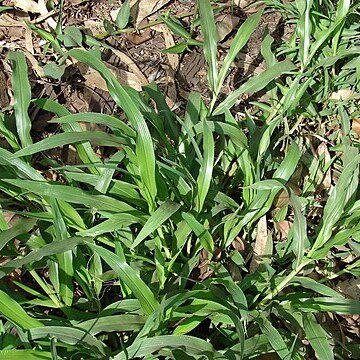Annual; culms 25-100 cm. high, erect or ascending, branching from the lower and sometimes the middle nodes, glabrous; sheaths much longer than the inter-nodes or the upper ones shorter, compressed, keeled, glabrous, or sparsely papillose-pilose, especially along the margins; ligule 0.5-2 mm. long, thin, brown; blades 5-40 cm. long, 5-12 mm. wide, thin, flat, acuminate, slightly rounded at the base, glabrous or papillose-pilose on the upper surface toward the base, the margins scabrous, mostly rather prominently papillose-ciliate; racemes 2-8, 2.5-8 cm. long, ascending or spreading, somewhat distant on the flattened axis, the rachis narrowly winged, about 1.5 mm. wide with a tuft of long hairs at the base; spikelets 2.2-2.3 mm. long, 3 mm. wide including the winged margins, paired, crowded; glume broadly ovate, apiculate, papillose, the margins with a broad, conspicuous, irreg-ularly notched, stiffly ciliate wing; sterile lemma a little shorter than the glume, obtuse, apiculate, the midnerve strong, the margins winged like the glume or usually only partially winged, sometimes wingless; fruit 2 mm. long, pale, ovate, minutely roughened, the nerves evident.
More
Annual. Culms tufted, erect, 30–100 cm tall. Leaf sheaths thinly hispid; leaf blades linear-lanceolate, 10–30 × 0.3–1 cm, both surfaces coarsely appressed hispid especially toward base, margins pectinate-ciliate, apex acuminate; ligule ca. 2 mm. Inflorescence axis 6–10 cm; racemes 3–5, 3–7 cm, loosely ascending, axils with long stiff hairs; spikelets usually paired but one of the pair often reduced; rachis flat, 1.2–1.5 mm wide, serrate-margined. Spikelets often purplish, circular in outline, 2.5–3.5 mm, acute; upper glume ovate, 3-veined, with stiff marginal wings ca. 1 mm wide, wings lacerate, wing margin ciliate with short stout hairs; lower lemma similar to upper glume but wing less developed; upper lemma ovate-elliptic, slightly shorter than spikelet, smooth, shining. Fl. and fr. summer–autumn. 2n = 40.


